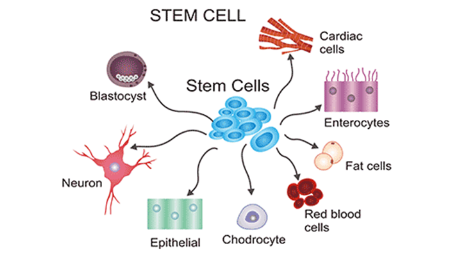What Are Stem Cells?
What are Stem Cells?
Stem cells are an intriguing and promising topic of scientific study with tremendous potential for revolutionizing medical treatments.
These unique cells have the astounding capacity to evolve into the different specialized cell types seen in the human body. They are the basis of life and play an important role in the development, growth, and maintenance of organs and tissues. Stem cells have various distinguishing characteristics that set them apart from all other kinds of cells in the body. Such as their ability to:
- Self-renew or create more copies of themselves.
- Differentiate into specific cell types with specified functions.
- Interact with the immune system and regulate its responses.
- Migrate to sites of tissue injury or inflammation guided by various signaling molecules.
Because of these inherent properties, they are a vital tool in regenerative medicine, with the ability to repair and regenerate damaged tissues and organs.

Because of these inherent properties, they are a vital tool in regenerative medicine, with the ability to repair and regenerate damaged tissues and organs.
Stem cells can be found in all stages of development, from embryos to adults, and they play an important role in tissue repair, growth, and regeneration. There are various forms of stem cells, each with their own set of properties and capabilities.
are derived from developing embryos, generally from surplus embryos produced during in vitro fertilization processes. These cells are pluripotent, which means they can differentiate into almost any of the more than 200 distinct cell types found in the human body.
are found in a variety of tissues and organs throughout the body, including bone marrow, skin, and the brain. Adult stem cells, unlike embryonic stem cells, are multipotent, which means they can differentiate into a restricted variety of cell types connected to their tissue of origin. For example, hematopoietic stem cells in the bone marrow can give rise to all types of blood cells including red blood cells, white blood cells, and platelets. Similarly, neural stem cells present inside the brain can produce a variety of nerve cells.
a new form of stem cell produced by transforming adult cells, for instance skin cells, into pluripotent states. When employed for therapeutic purposes, iPSCs can be produced from an individual’s own cells, lowering the danger of immunological rejection.

The characteristics of stem cells make them a powerful tool in the field of regenerative medicine, with potential applications for a variety of medical diseases. Researchers and physicians are exploring new paths for treating diseases and injuries that were formerly thought to be incurable or untreatable by utilizing the regenerative properties of stem cells. Stem cell therapies have promise for a variety of ailments, including Parkinson’s disease, spinal cord injury, heart disease, diabetes, and others. While stem cell research is still in its early stages, its promise to alter medicine is apparent. Scientists are making considerable progress towards comprehending the biology of stem cells and creating safe and effective ways for their therapeutic application, with the intention to harness these unique cells to improve the health and well-being of countless people.

The characteristics of stem cells make them a powerful tool in the field of regenerative medicine, with potential applications for a variety of medical diseases. Researchers and physicians are exploring new paths for treating diseases and injuries that were formerly thought to be incurable or untreatable by utilizing the regenerative properties of stem cells. Stem cell therapies have promise for a variety of ailments, including Parkinson’s disease, spinal cord injury, heart disease, diabetes, and others. While stem cell research is still in its early stages, its promise to alter medicine is apparent. Scientists are making considerable progress towards comprehending the biology of stem cells and creating safe and effective ways for their therapeutic application, with the intention to harness these unique cells to improve the health and well-being of countless people.
What is stem cell therapy?
Stem cells therapy, also known as regenerative medicine, is the future medicine as it has enormous medicinal and biotechnological potential. Stem cells can be engineered to become tissue-specific cells able to repair or replace damaged tissues. As a result of stem cell therapies, autoimmune disorders and/or disorders associated with tissue damage can be treated with reduction in symptoms or complete recovery depending on the condition. The uses of stem cells, which serve as the body’s building blocks, are countless. Because they can replace, regenerate, and repair nearly any type of cell, these powerful cells are special. It’s a once-in-a-lifetime chance to collect a priceless resource that might one day be utilised to cure a major disease or illness by storing your baby’s stem cells at birth. Your baby’s stem cells may also match those of their siblings or parents and be used to treat them. These cells are effectively preserved at birth in their healthiest and most potent state.
The characteristics of stem cells make them a powerful tool in the field of regenerative medicine, with potential applications for a variety of medical diseases. Researchers and physicians are exploring new paths for treating diseases and injuries that were formerly thought to be incurable or untreatable by utilizing the regenerative properties of stem cells. Stem cell therapies have promise for a variety of ailments, including Parkinson’s disease, spinal cord injury, heart disease, diabetes, and others. While stem cell research is still in its early stages, its promise to alter medicine is apparent. Scientists are making considerable progress towards comprehending the biology of stem cells and creating safe and effective ways for their therapeutic application, with the intention to harness these unique cells to improve the health and well-being of countless people.
What is stem cell therapy?
Stem cells therapy, also known as regenerative medicine, is the future medicine as it has enormous medicinal and biotechnological potential. Stem cells can be engineered to become tissue-specific cells able to repair or replace damaged tissues. As a result of stem cell therapies, autoimmune disorders and/or disorders associated with tissue damage can be treated with reduction in symptoms or complete recovery depending on the condition. The uses of stem cells, which serve as the body’s building blocks, are countless. Because they can replace, regenerate, and repair nearly any type of cell, these powerful cells are special. It’s a once-in-a-lifetime chance to collect a priceless resource that might one day be utilised to cure a major disease or illness by storing your baby’s stem cells at birth. Your baby’s stem cells may also match those of their siblings or parents and be used to treat them. These cells are effectively preserved at birth in their healthiest and most potent state.
There are two main types of stem cell transplant
They are different because the stem cells you receive are collected from different sources.

If you have an autologous (or autograft) transplant, you will receive your own stem cells that were collected before your treatment started.
If you have an allogeneic (or allograft) transplant, you will receive stem cells from somebody else. This might be someone you know, such as a sibling or family member, or it could be someone who has signed up to the Anthony Nolan register.

The type of transplant you have will depend on the type of blood cancer or blood disorder you have, your age and general health. The availability of a suitable matched donor is also a factor.
An allogeneic stem cell transplant is a potentially lifesaving treatment for people with blood cancer and blood disorders, which works by replacing damaged blood cells with healthy ones.
Every year in England, approximately 1,100 adults and 300 children receive an allogeneic stem cell transplant. The total number is increasing at an average rate of 5% year-on-year. Adults most commonly receive an allogeneic stem cell transplant to treat blood cancer, whereas children most commonly receive an allogeneic stem cell transplant to treat a blood disorder.
In the past, bone marrow was the primary source of stem cells and it has been used successfully for over 25 years to treat more than 80 illnesses. Blood and bone marrow contain cells known as hematopoietic progenitor cells (HPCs) or hematopoietic stem cells (HSCs). The mature blood cells that carry oxygen, control bleeding, and fight infections, such as red blood cells, platelets, and white blood cells, can all be produced by HPCs. HPCs are utilised to rebuild a patient’s hematopoietic system and treat a variety of malignant (such as leukaemia, lymphoma) and non-malignant (such as sickle cell disease) disorders. Performing a bone marrow or stem cell transplant is the medical term for this procedure. Additionally, HPCs have been utilised in clinical trials for the treatment of hereditary and autoimmune illnesses, among other purposes.

The type of transplant you have will depend on the type of blood cancer or blood disorder you have, your age and general health. The availability of a suitable matched donor is also a factor.
An allogeneic stem cell transplant is a potentially lifesaving treatment for people with blood cancer and blood disorders, which works by replacing damaged blood cells with healthy ones.
Every year in England, approximately 1,100 adults and 300 children receive an allogeneic stem cell transplant. The total number is increasing at an average rate of 5% year-on-year. Adults most commonly receive an allogeneic stem cell transplant to treat blood cancer, whereas children most commonly receive an allogeneic stem cell transplant to treat a blood disorder.
In the past, bone marrow was the primary source of stem cells and it has been used successfully for over 25 years to treat more than 80 illnesses. Blood and bone marrow contain cells known as hematopoietic progenitor cells (HPCs) or hematopoietic stem cells (HSCs). The mature blood cells that carry oxygen, control bleeding, and fight infections, such as red blood cells, platelets, and white blood cells, can all be produced by HPCs. HPCs are utilised to rebuild a patient’s hematopoietic system and treat a variety of malignant (such as leukaemia, lymphoma) and non-malignant (such as sickle cell disease) disorders. Performing a bone marrow or stem cell transplant is the medical term for this procedure. Additionally, HPCs have been utilised in clinical trials for the treatment of hereditary and autoimmune illnesses, among other purposes.
Other form of stem cell therapy is Tissue grafts which involves the transplantation of stem cells into damaged or diseased tissues, such as the heart, brain, or joints, in order to promote regeneration and repair. Another form of therapy is stem cell injections that involves the direct injection of stem cells into a specific area of the body, such as the knee joint, in order to promote healing and reduce inflammation.
It’s intriguing to think about how stem cells could be able to repair damaged tissue and cells. Stem cell transplants are regarded as a conventional form of treatment for more than 80 illnesses. An individual’s blood and immune system can be rebuilt by a cord blood stem cell transplant by swapping out unhealthy old cells for new, healthy ones. More recently, it has been demonstrated that cord blood stem cells can develop into other tissues like bone and nerve cells. The use of cord blood stem cells in regenerative medicine is highly promising. These cells can differentiate into a variety of cell types, including neuron, bone, skin, heart, and liver cells, according to research. It has also been demonstrated that they encourage the body’s natural mending processes.

